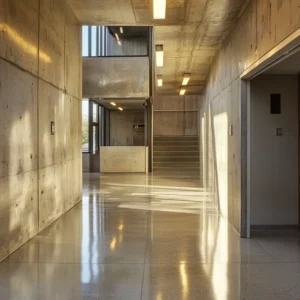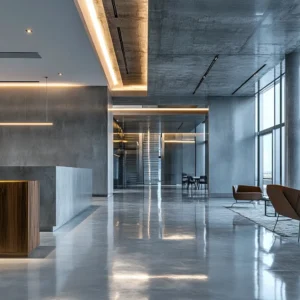Commercial Building Projects
Introduction to Fiber-Reinforced Concrete and Its Significance
Defining Fiber-Reinforced Concrete
Fiber-reinforced concrete (FRC) is concrete enhanced with discrete fibers which provide improved tensile strength, resistance to cracking, and ductility. Fiberego leverages this technology to meet the increasing demands of modern commercial architecture, where durability and aesthetic flexibility are paramount.

Material Performance Demands in Commercial Construction
Commercial building projects require materials that can withstand the rigors of heavy use and environmental stress. FRC is ideal for these applications due to its enhanced performance characteristics, including improved longevity and reduced maintenance needs.
Types of Fibers Used in Commercial Building Projects
Fiberego incorporates various fibers into concrete mixes to address specific structural and design requirements:
- Fibra de polipropileno: Offers excellent crack resistance and durability.
- Fibra de poliéster: Known for its high tensile strength and bonding capabilities.
- Polyacrylonitrile Fiber (PAN): Provides high strength and thermal stability.
- Fibra de aço: Increases load-bearing capacity and overall toughness of the concrete.
- Fibra de celulose: Enhances fire resistance and contributes to sustainability efforts.
Performance Advantages of Fiber-Reinforced Concrete
Enhancing Crack Resistance
Fibers distributed throughout the concrete significantly reduce the formation of cracks, which is crucial for the structural integrity of commercial buildings.

Improving Impact Resistance
FRC excels in absorbing impact energy, making it ideal for areas in commercial buildings that are susceptible to heavy traffic or mechanical impact.
Boosting Durability
The inclusion of fibers in concrete extends the lifespan of commercial structures, reducing the need for frequent repairs and replacements.
Applications of Fiber-Reinforced Concrete in Commercial Buildings
H3: Flooring and Parking Areas
FRC is extensively used in flooring and parking areas of commercial buildings to withstand constant vehicle traffic and load stress.
External Walls and Facades
FRC not only provides structural benefits but also offers aesthetic versatility for facades and external walls, enhancing both the visual appeal and functional resilience of buildings.

Internal Structural Applications
In internal structures, FRC contributes to fire resistance and sound insulation, improving the overall safety and comfort of commercial spaces.
Design and Construction Considerations
Selecting Fiber Type and Concrete Mix
Choosing the right type of fiber and determining the optimal mix are crucial for achieving the desired performance and aesthetic outcomes in commercial constructions.
Construction Techniques and Challenges
Implementing FRC requires precise mixing and pouring techniques to ensure even distribution of fibers and optimal concrete properties.
Quality Control and Performance Testing
Continuous quality assurance and performance testing are vital to ensure that the FRC meets or exceeds the specified standards for commercial projects.

Future Trends and Sustainability in Fiber-Reinforced Concrete
Innovations in Fiber Technology
Ongoing research into fiber technology promises even more durable and environmentally friendly FRC solutions in the future.
Fiber Concrete in Green Building
The role of FRC in sustainable building practices is expanding, with a focus on reducing environmental impact through innovative material compositions and recycling.
Environmental Impact and Sustainability Analysis
Fiberego is committed to advancing sustainable construction practices by optimizing the use and production of FRC to minimize environmental footprints.
Conclusion: Fiberego’s Commitment to Advanced Commercial Building Solutions
Fiberego remains at the forefront of developing fiber-reinforced concrete solutions that cater to the evolving needs of the commercial construction industry. With a focus on innovation, quality, and sustainability, Fiberego is helping to shape the future of commercial architecture.


